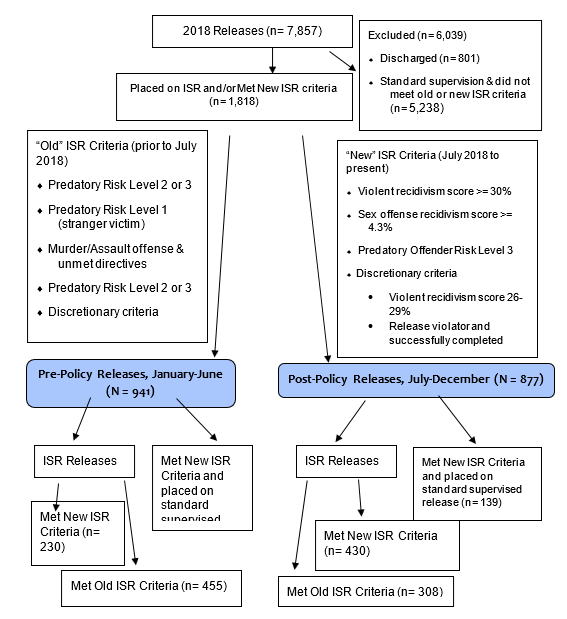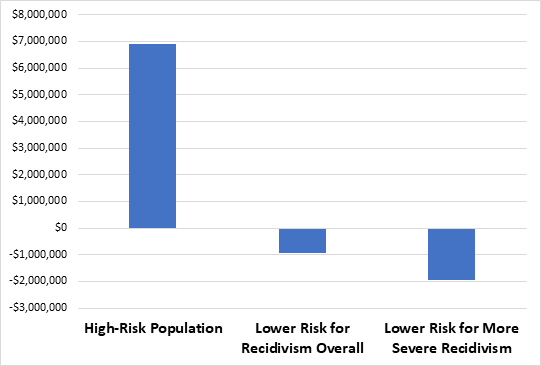
 In Minnesota, corrections authorities have used a program known as intensive supervised release (ISR) to monitor some of those who leave prison in the state. In new research Grant Duwe and Susan McNeeley examine the effects of recent reforms to the program which take into account the risk of reoffending by those released. They find that, compared to standard supervision, the new program reduced reoffending, and was cost-effective.
In Minnesota, corrections authorities have used a program known as intensive supervised release (ISR) to monitor some of those who leave prison in the state. In new research Grant Duwe and Susan McNeeley examine the effects of recent reforms to the program which take into account the risk of reoffending by those released. They find that, compared to standard supervision, the new program reduced reoffending, and was cost-effective.
Since 1990, a subset of people exiting prison to community supervision in Minnesota have been released under intensive supervised release (ISR). ISR includes house arrest and electronic monitoring, especially in the early stages after release. The program also involves more face-to-face contacts with agents than standard supervision, unannounced visits to one’s home and work, and mandates spending at least 40 hours a week engaged in constructive activity, such as work, education, training, and/or treatment.
In July 2018, the Minnesota Department of Corrections (MnDOC) adopted new criteria for placement on ISR. Prior to July 2018, ISR placement was based on factors relating to offense type and risk level (see Figure 1). The new criteria for ISR placement are based entirely on the risk of reoffending (also known as recidivism), as measured by the Minnesota Screening Tool Assessing Recidivism Risk 2.0 and the Minnesota Sex Offender Screen Tool-4.
Figure 1 – Flow Diagram for Placement on Intensive Supervised Release (ISR) Before and After Policy Change in July 2018

This change in ISR policy created a natural experiment in which we could examine whether ISR is more or less effective than standard supervision. We found that individuals released on ISR had lower risk of rearrest and reconvictions and were rearrested and reconvicted fewer times than those released on standard supervision but had higher risk of being returned to prison for a technical violation (technical violations can include non-criminal activities such as using alcohol, not following curfew, or not maintaining contact with a parole agent). We also found that ISR as implemented in Minnesota is a cost-effective practice.
Intensive Supervised Release (ISR) Reduced Reoffending
Prior research on intensive supervision suggests it’s costly and increases technical violation revocations due to greater scrutiny – however, most of this research was carried out roughly three decades ago. To conduct a modern test of the effectiveness of ISR compared to standard supervision, we used a sample of people released from Minnesota prisons in 2018, which included six months before and after the policy change. During this time, there were 1,818 releasees who met either the old or the new ISR criteria.

“Untitled” by Neil Conway is licensed under CC BY 2.0.
For those individuals, we measured five types of recidivism over a 1-2-year follow-up period: any rearrest, any reconviction, violent reconviction (including sex offenses), felony reconviction, and return to prison for a technical violation revocation. We examined both the amount of time between release and the first recidivism event and the number of rearrests or reconvictions during the follow-up period.
Our findings showed ISR decreased the risk of rearrest by 38 percent, reconviction by 28 percent, felony reconviction by 34 percent, and violent reconviction by 34 percent. Similarly, ISR significantly reduced the number of rearrests and reconvictions for general and felony reoffending. On the other hand, the findings showed the risk of a technical violation revocation was nearly 150 percent greater for those placed on ISR.
Is the Higher Cost Worth It?
ISR is costlier to operate than standard supervision; therefore, we also analyzed the cost-effectiveness of ISR by comparing the costs of running the program with the benefits it produces by reducing reoffending. ISR costs the state an estimated $6.6 million a year more than regular supervision. The increase in returns to prison for technical violations produce an additional reimprisonment cost; we found that the additional revocation among ISR participants amounted to an estimated $2.4 million a year.
While our analyses show that ISR reduces reoffending, do the reduction in costs associated with these crimes exceed the estimated almost $9 million that ISR costs the state each year? To answer this question, we monetized the costs of specific reoffenses committed by the people in our sample based on estimates developed by prior research. We found that the average cost of the crimes committed by the people in our sample was $73,737. The results of our model suggest that ISR prevented 215 new offenses. Therefore, we estimate that the state saved $15.9 million in new offenses due to the use of ISR. This exceeds the costs associated with ISR by $6.9 million.
These favorable results would look different if the target population was less risky, if they reoffended less or committed less serious crimes. As shown in Figure 2, if the people placed on ISR were responsible for, say, half the number of reconvictions, then ISR would no longer yield a benefit. Instead, it would generate a cost close to $1 million. Moreover, if the cost of the crimes prevented were less violent, then the overall cost would approach $2 million.
Figure 2 – Total Estimated Benefits by Recidivism Risk of Target Population 
Maximizing the Success of ISR Programs
Our results show that ISR reduces reoffending, and the savings produced by preventing reoffending balances the increased costs related to higher technical violation revocations. However, relying on revocations can be problematic when those who are revoked tend to be warehoused in prison without access to programming. Agencies should pursue alternatives to incarceration for those who violate technical conditions of supervised release, and/or provide programming to those incarcerated due to technical violation revocation.
As shown above, the cost-effectiveness of ISR hinges on applying it to a higher-risk population who are more likely not only to reoffend but also to commit more violent, serious crimes when they reoffend. Therefore, it is vital to implement accurate risk assessment instruments. Similarly, ISR will not be cost-effective if it has a smaller impact on recidivism. Therefore, intensive supervision should be paired with effective therapeutic programming.
- This article is based on the paper, ‘The Effects of Intensive Postrelease Correctional Supervision on Recidivism: A Natural Experiment’, in Criminal Justice Policy Review.
Please read our comments policy before commenting.
Note: This article gives the views of the author, and not the position of USAPP – American Politics and Policy, nor the London School of Economics.
Shortened URL for this post: https://bit.ly/31V1AK3
About the authors
 Grant Duwe – Minnesota Department of Corrections
Grant Duwe – Minnesota Department of Corrections
Grant Duwe is the director of research and evaluation for the Minnesota Department of Corrections, where he evaluates correctional programs, develops risk assessment instruments, and forecasts the state’s prison population. His recent work has been published in Corrections: Policy, Practice and Research, Journal of Experimental Criminology, Journal of Offender Rehabilitation, Law and Human Behavior, and The Prison Journal.
 Susan McNeeley – Minnesota Department of Corrections
Susan McNeeley – Minnesota Department of Corrections
Susan McNeeley is a research analyst with the Minnesota Department of Corrections. In addition to corrections, her research has focused on criminological theory and victimology. Her recent work can be found in Journal of Experimental Criminology, Crime and Delinquency, Journal of Criminal Justice, and Criminal Justice and Behavior.



